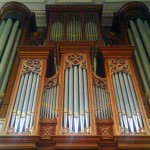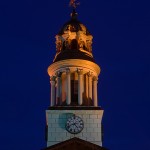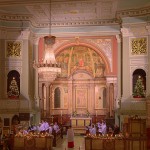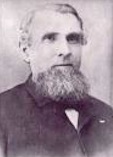Written in 1967 by Fred A. Tice (1891 – 1977)
Introduction and commentary by Larry Pearce
3/17/01, 11/30/07, 10/8/15 & 10/9/18
The author of this work, Fred Tice, was the son of Henry and Lillie Pearce Tice and grandson of Edwin and Susan Anderson Pearce, and lived near Shreve, just south of Wooster in east-central Ohio. Edwin was one of the older brothers of my great-grandfather Charles Pearce (1834-1914). Pearces and Austens still live in that part of the state today. Fred recorded the 50th wedding anniversary of his parents in 1929 at which many of the family gathered. During the ceremony, his sister, Bertha Hughes, read an account supposedly given to her by Susan Austen Grubbs (1814 – 1899), daughter of Charles and Susan Pearce Austen and sister of Charles Austen, Jr. and Thomas P. Austen, all first generation Americans. The narrative was revised in 1949 and was widely distributed among members of the family. Apparently, this is the source of the “Original Austen-Pearce Family Narrative” we’ve been commenting on in our E-Gen: Pearce articles. Other contributors to the story, according to Fred, included his mother’s sisters, Ida Pearce Van Niman and Blanche Pearce Collier.
Three years after the revision, Fred and his wife Opal visited England to verify as much as possible before their deaths. His story, which also includes information on the Tice line from Germany, is thrilling, to say the least. But, some questions continue to haunt readers. For example, why does one of Thomas P. Austen’s children credit him/herself with writing the Original Narrative when Susan Austen Grubbs, Thomas’ sister, is given credit for writing it in the Tice account? Thomas and his brother Charles, Jr. each had nine children, but none of them is ever mentioned. We have other questions, but let’s go directly to Fred’s story (in my italics)and make his discoveries our own:
[Page 4] Turning now to the Pearce and Austen families, let me hasten to correct the impression made in a statement by Mrs.Susan Austen Grubbs and quoted by Bertha at the golden wedding anniversary. This was that her (Mrs. Grubbs) grandfather, Charles Austen, son of Ambrose Austen, was captain of a British man-of- war in the fleet which defeated the Spanish in the famous Battle of the Spanish Armada. [Actually, the Original Narrative suggests that it was Charles’ uncle, also named Charles, who was captain.] Pedigree Chart number III shows that this Charles Austen was born in 1785. And since the Battle of the Spanish Armada took place in 1588, this Charles Austen could not have been involved. However, he may well have been a captain in the British Navy in the Napoleonic Wars, 1798-1812, in which there was another so-called “Armada.”
It was in the Napoleonic Wars that Nelson defeated the allied French and Spanish fleets at Trafalgar, near the Strait of Gilbralter, ending Napoleon’s power at sea. As this battle took place on October 21, 1805, and President Thomas Jefferson had made the famous Louisiana Purchase in 1803 from France, we can get a concept of time relationship to events in America.
As to the accuracy of Mrs. Grubbs in telling about the status of the Austens, I can not affirm or deny. From notes Opal and I made at the Society of Genealogists in London in 1952 [see WWW.SOG.ORG.UK], it seems certain that Charles Austen, the one who married Susan Pearce in 1813, served in the Army and Navy as an officer. Since commissions in the military service were granted only to the landed gentry, and had to be bought, it is apparent that the Austens and Pearces were well.-to-do people.
When [we] told the archivist of our interest in the double wedding, Pearce Austen, and in the Captain who helped defeat the Spanish Armada, she said ” There is a slight error of two hundred years, ” and added that she had been corresponding with a Dr. Willard Austen of New York who had made similar inquiries. She showed me his pedigree, copy in my materials, Pedigree Chart number II’I. It was easy to make the connection between his Austens and my Pearces. Later we corresponded with Dr. Austen and had dinner in his home when on our way to Europe in 1958. He had very good family records, but he died on Christmas Day, 1964. [His niece in Seattle is now part of our network.]
The young lady at the Society told Opal and me that the church which we had called St. Mary’s on the Bourne was now referred to as St. Marylebone and was within easy walking distance. [see maps at WWW.LONDONTOWN.COM.] On the way there we crossed Wimpole Street where Robert Browning had courted Elizabeth Barrett despite her father’s wishes. In fact, they, too, had been married in this same church on September 12, 1846. The warden, Mr. Collins, told us that Mr. Barrett, suspecting an elopement, rushed to the church but the bride and groom had left for Italy. Mr. Barrett was so angry, said Mr. Collins, that he went home and kicked the dog, probably Fluff.
A few words more about this church might be worth while. John Wesley, the founder of Methodism, had been a member of St. Marylebone. Also, Charles Dickens, Lord Nelson, Lord Byron, Francis Bacon, and Charles Wesley.
The original congregation built a small church in the thirteenth century near the Tybourn stream in a district called Tybourn, famous chiefly as the locale of the Tybourn Tree where criminals were hanged. The tree was located near the site where the Marble Arch now stands in Hyde Park and is marked by a white stone set into the pavement. In 1958 I walked into the heavy traffic to see it while Opal watched from the window of our room in the Cumberland Hotel.
The church was called St. John the Evangelist at Tybourn. In 1400 a new church was built about a half mile higher up the bourne and was dedicated to St. Mary – St. Mary by the Bourne (a stream). By the middle of the fifteenth century the name Tybourn had given place to that of Marybourne because of the unpleasant association with the hangings. This in turn became St. Marylebone. [see WWW.STMARLYBONE.ORG.]
[Speaking of the hangings, I’m reminded of] an exchange of letters between Dr. Austen and me. When Opal and I visited the church in 1952, and asked the warden, Mr. Collins, if we could see the record of the double wedding, he took us into the office and brought from the vault the record book for 1813. Turning to June 21st, he pointed to names we wanted to see – a thrilling experience! [Fred says that this record book has since been transferred to the London County Record Office.]
Having just learned about Dr. Austen, I thought it would be fun to write him and say that I had proof that our great-grandparents had been married. Replying in the same spirit, he wrote that it might interest me to know that the last pirate hanged on Tybourn Tree was a man by the name of Austen!

Grand pipe organ St. Marylebone Church London
This was the church building in which the double wedding took place. Being a very small structure, and the city of London having since enveloped the area, it needed to be replaced by a larger structure. This was done in the same church yard. In fact, the foundation stone for it was laid on July 5, 1813, just two weeks after the day of the double nuptials. And the little old church had stood nearby until World War II, roughly 450 years, at which time it was damaged by bombs and had to be razed. Mr. Collins, the warden, took us to the site and I stood where Mr. Collins said the bride and groom would have stood. Embedded in the original foundation were old grave-stones, and where the altar had been, a memorial statue to Charles Wesley had been placed.
Having, as I believe, set straight the accounts which we had of the background of the Pearce-Austen families, I have not tried to discover additional materials. It is my hope that this record will serve as a sound basis for further research by other descendants. From here on I am merely reproducing parts of the paper which Bertha read in 1929. Much of it is Bertha’s composition, the paragraphs in quotation marks being those of Mrs. Grubbs.
It is difficult to determine what is in quotes in Fred’s script, and some of the wording and order is slightly different from the “Original Austen-Pearce Family Narrative” as posted. For example, Fred says, referring to Charles Austen’s move from Castle Gate Manor, “After some years he became dissatisfied and sold out. Sold his right to the Castle, sold his immense flocks of sheep and went to St. Albans. There he stayed for four years, then went to Litchborough, and in two years started for America.” The Original says that Charles became dissatisfied after four years. If he and Richard Pearce started for America in 1820 and we subtract six years, that means he was still at Castle Gate in 1814. The double wedding took place in 1813 and there is a reference to Sarah and Charles returning to the Manor after the wedding, so had the wedding taken place before Charles sold out?
Also, in Fred’s quoting the Austen Grubbs account, he gives a different point of view from that in the Original Narrative saying, “Susan Austen – Pearce – had as much household goods as Grandmother Pearce – Austen,” as if Susan weren’t also her grandmother. Did the honeymoon last eight days after which they “packed up all their belongings preparatory to moving to America?” Did they know then in 1813 that they would leave England in 1820? Or is this part of the sometimes confusing narrative taking place just prior to the men leaving in 1820? There is some speculation that perhaps part of the Austen family had come to America prior to 1820. They were from Kent County, famous for its hops growing, a main ingredient in beer, and some sources say that at least one of the Austens went to Ohio to continue that business. Hops must be ground before being used in brewing. We know that Richard Pearce was “a miller by trade,” so was our family involved in that grinding hops? We’ll have more about the Austens of Kent in the future.
We are told in Fred’s account that the Pine Creek property in America was offered by the owner, a Mr. Butler, at 20 cents an acre. This differs from the Original which says 50 cents an acre and omits the owner’s name in favor of caretaker Cochran and his brother-in-law Davis. A trip to the Allegheny County Courthouse may confirm this addition.
Now, for another major claim made by Fred and omitted from our Original: “In the fall of 1820 they both (Richard and Charles) started back to England and in January of 1821 sold all their household good and disposed of all their property (in England). We questioned in an earlier article whether the men would leave their new American investment for eight or nine months and sail back to England to accompany their wives to America, especially when perhaps friends and neighbors such as the Toogoods were helping. We also learn that the storm referred to in an earlier article that kept them off course on their voyage back west was indeed in the Bay of Biscay, “off France.”
Fred’s account reveals that the large wagon that delivered the nine Austens and Toogoods from Philadelphia to Pittsburgh was “probably a Conestoga” made in nearby Lancaster. The Original Narrative says that Richard Pearce purchased a “light” wagon for the trip, probably a smaller flatbed or buckboard, which could outrun and out-maneuver the bigger Conestoga. He must have been in a hurry to get to his new home.
The “Tice-Pearce Heritage” offers some information on the Pearce homestead in what is now North Park near Pittsburgh. We’ll revise and add to that in a future article, but in closing, we offer Fred’s final information on his Grandfather Pearce, my Great-Grandfather Charles Pearce’s older brother:
[Page 6] In 1873 Edwin moved with his family to Ohio. Seven children were born to them – Calvin, Lillie, Ida, Elizabeth, Thomas, Blanche and Kate. Grandfather, like his father [Richard], was a miller and, near Shreve, Ohio – 1 1/2 miles east of town, built a mill which operated by a water wheel. One section of the grind-stone is on exhibit at the Wayne County Historical Society, Wooster, Ohio. (see WWW.WAYNEHISTORICAL.ORG.) Later an engine was put in. Still later, probably around 1885, he moved to Shreve, Ohio and built the first roller mill. This building still stands on the original spot, although it has now been remodelled.
Grandfather was a jolly man – typically English. I remember his rosy cheeks and merry twinkling eyes, a great man for joking with his friends. When I was young and taught school five miles from home in the country, he would hitch up my father’s horse and come after me every evening. And how I enjoyed those rides! My parents lived beside my grandparents for a number of years.
Mother [Lillie] said Grandfather used to keep a set of boxing gloves in the mill and in his younger days was a proficient boxer and bested many a man who challenged him. My earliest recollection is of his comfortable home east of town. Here, when men came to the mill to have grinding done, it was an all day job and “Brother Pearce” always insisted that they stay for dinner. The genial host kept my Grandmother and aunts busy cooking, I am sure. Their reputation for cooking extended as far as the mill drew its customers because they told many times of the good meals served. He believed firmly in, eating whole wheat made into a porridge. Grandfather Pearce was a religious man and lived his religion. I can see him yet in the Methodist Church standing with his eyes shut, hands behind his back enjoying the singing of the hymns.
While Grandfather was a man of many jokes, Grandmother [Susan Anderson] Pearce was, very sedate and not inclined always to smile at his sallies. Her reply was, “Oh, Pa, how you talk! ” She was a good woman and always gave as she could afford to all the benevolences of the church. Fred tells of his embarrassment when she asked what the preacher’s text had been and he had not the vaguest idea. When young she was a teacher in the schools in her neighborhood. Grandmother was a true lady. She and Grandfather each lived to be past eighty years of age and are buried in the Shreve Cemetery, as are Henry and Lillie Tice [Fred’s parents].
So, here we have probable answers to some important questions from the Original Austen-Pearce Family Narrative: Where did it come from and who wrote it? Was there actually a double wedding in “The Queen’s Church” in 1813 with royalty attending? (See “On the 200th Wedding Anniversary of Richard and Susan Austen Pearce.”) Did the young wives and six children have to sail to America by themselves? But there are more questions to answer. We hope to report the answers to these mysteries in future articles as our discoveries continue thanks to friends and family around the world.
Last revised 10/9/18





